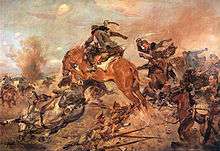Charge of Rokitna
The Charge of Rokitna (Polish: Szarża pod Rokitną) was a charge of a cavalry squadron of the 2nd Brigade of Polish Legions, fighting for the Austro-Hungarian Army. It took place on June 13, 1915 near the village of Rokytne, which at that time was part of Austrian province of Bukovina. A Polish squadron of 70 uhlans, led by Rittmeister Zbigniew Dunin-Wasowicz, attacked positions of the Imperial Russian Army. The battle resulted in a Polish pyrrhic victory: out of 70 soldiers, Poles lost 17 KIA and 23 wounded. Russian losses are unknown.

Background
In spring of 1915, the 2nd Brigade was reorganized. It was divided into three tactical groups, commanded by Marian Januszajtis-Zegota, Józef Haller and Bolesław Roja. On April 1, 1915, Austrian Army Colonel Ferdinand Kuttner was named commandant of the 2nd Brigade. On April 17, Polish Legions were sent to Bukovina, where they became part of forces of General of Cavalry Ignaz Edler von Korda.
Third Legions Infantry Regiment was ordered to man frontline between the villages of Dobronowce (Dobronauti) and Toporowce (Toporivtsi). Polish artillery was located at Balamutowka (Balamutca), uhlans of the 3rd squadron were in the area of Rarancza, while 2nd squadron stayed in the town of Kotul-Ostrica. In the first days of June, 2nd and 3rd uhlan squadrons were merged into the 2nd Regiment of the Legions Cavalry, under command of Rittmeister Zbigniew Dunin-Wasowicz.
Charge
On June 12, 1915, the 2nd Brigade operated in the area of the village of Rokytne, Austrian Bukovina. On both sides of it were units of the Austro-Hungarian Army: all forces initiated a joint attack on Russian positions. Despite heavy fighting, Polish and Austrian regiments failed to achieve their objectives.
On June 13 in early afternoon, the Russians began their advance from positions in the area of Rokitna. In order to halt the enemy, Austrian headquarters ordered Rittmeister Dunin-Wasowicz to carry out an attack with both uhlan squadrons of the 2nd Legions Brigade. They were to advance along the left wing, supporting Austrian infantry which simultaneously would attack Russian trenches.
Rittmeister Dunin-Wasowicz personally headed the charge: after crossing muddy banks of the Rokitnianka river, 3rd squadron was kept in reserve, while 2nd squadron charged. Within 15 minutes, Polish uhlans broke through three lines of Russian trenches. Polish losses were very high, but their sacrifice was not utilized, as the Austrian infantry failed to advance. Among those killed in action were Dunin-Wasowicz himself, also Colonel Jerzy Topor-Kisielnicki (commandant of 2nd squadron) and his deputy Roman Prawdzic-Wlodek.
Aftermath
On June 15, 1915, at a cemetery in Rarancza, a funeral of uhlans killed in action took place. The service was led by Reverend Jozef Panas, coffin of Dunin-Wasowicz was covered with red cloth with Polish Eagle. Since in the interwar period the cemetery at Rarancza was part of Romania, a Polish ally (see Polish–Romanian Alliance), Romanian 11th Rosiori Regiment took care of the tombs.
In February 1923, exhumation of bodies of Polish soldiers took place. All remains were transported to Poland, and on February 26, 1923, in Kraków, an official funeral took place, with such notable figures present at the ceremony, as Józef Piłsudski and Cardinal Adam Sapieha. Pilsudski posthumously awarded Virtuti Militari 5th Class to all soldiers. After the funeral, all coffins were transported to Rakowicki Cemetery. Two years later, a monument of the uhlans was unveiled there.
The Charge of Rokitna was the basis for a zurawiejka, "Song of the Squadron of Wasowicz". It also is mentioned in The Red Poppies on Monte Cassino, one of the best-known Polish military songs of World War II.
On the Tomb of the Unknown Soldier, Warsaw, the charge is mentioned as "ROKITNA 13 VI 1915".
See also
Sources
- August Krasicki: Dziennik z kampanii rosyjskiej 1914–1916. Warszawa: Instytut Wydawniczy PAX, 1988. ISBN 83-211-1000-2.
- Stanisław Jan Rostworowski: Nie tylko Pierwsza Brygada (1914–1918) – Z Legionami na bój. Warszawa: P. W. EGROS – Oficyna Wydawnicza, 1993. ISBN 83-85253-05-X.
- Andrzej Czesław Żak Rokitna 1915 Wydawnictwo Bellona, Warszawa 1994, ISBN 83-11-08294-4.
- Wacław Lipiński: Walka zbrojna o niepodległość Polski w latach 1905–1918. Warszawa: "Wolumen"